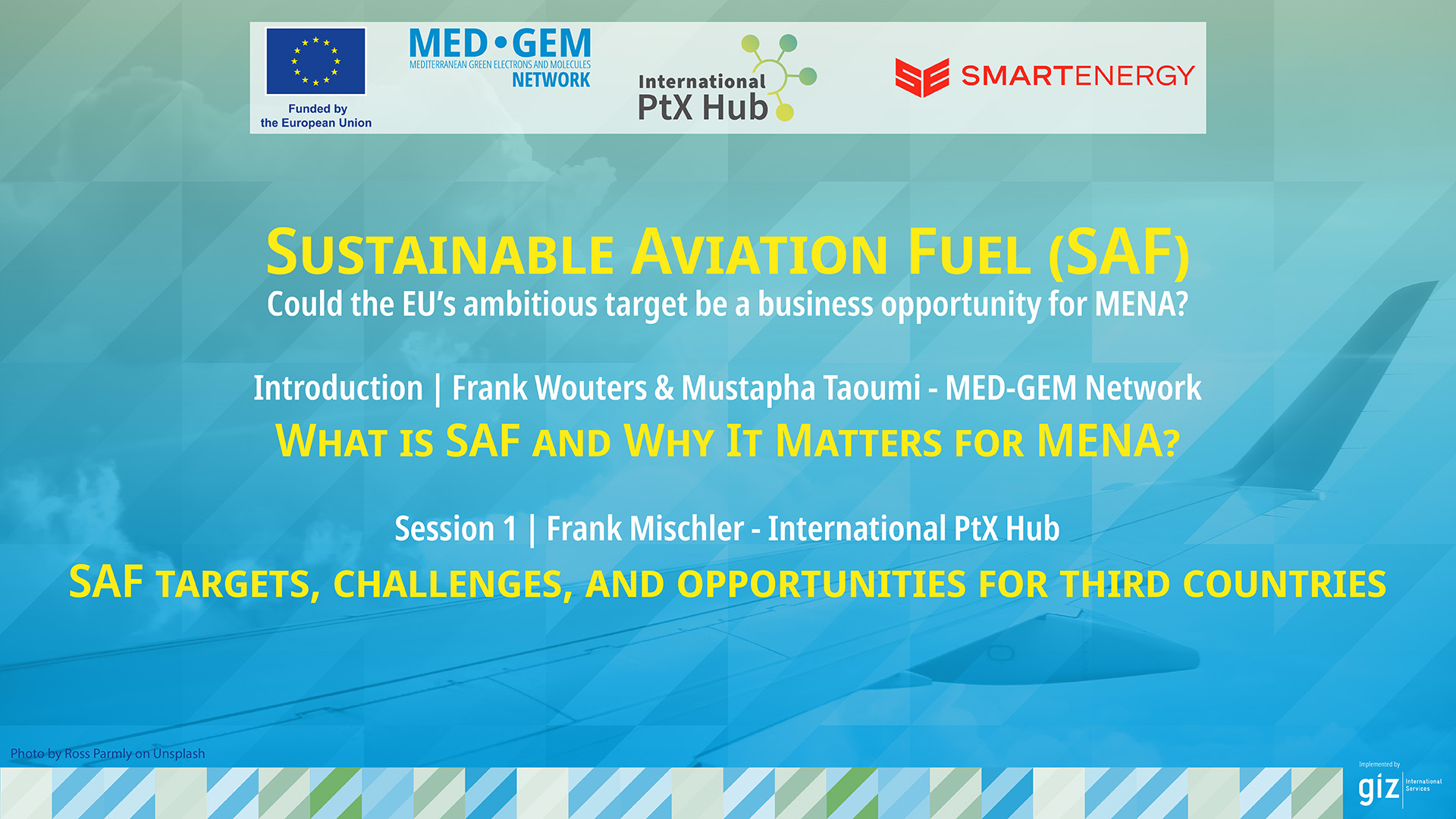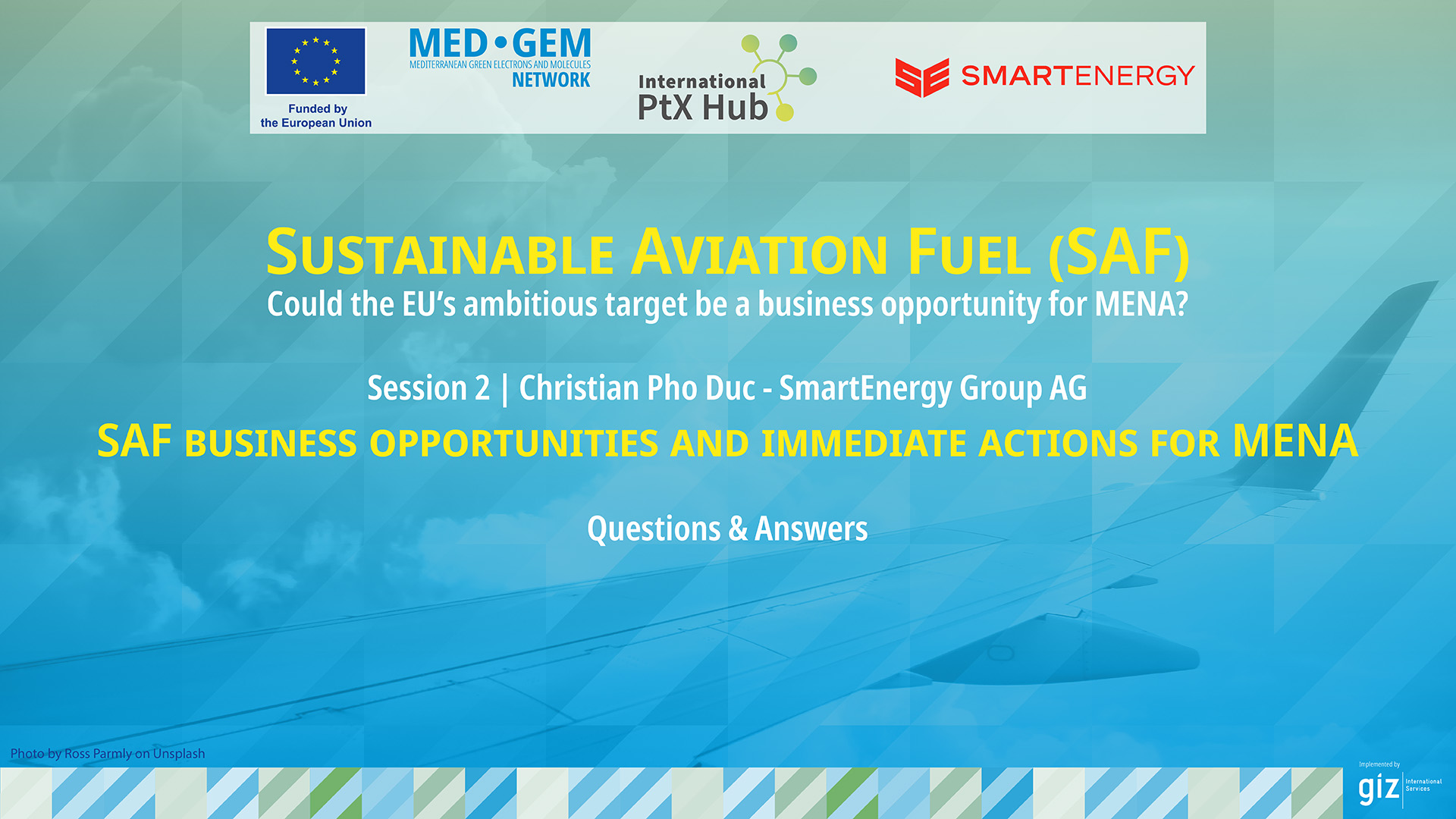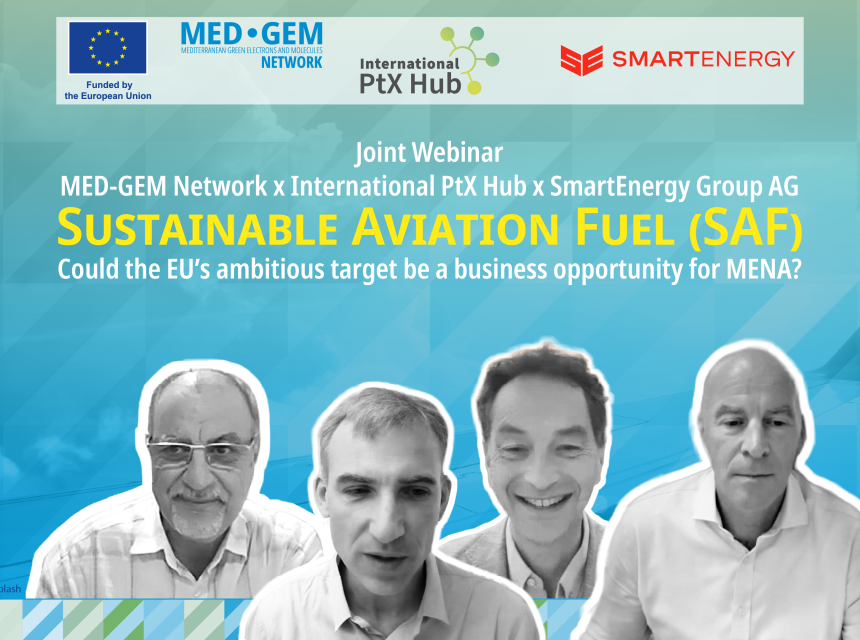Sustainable Aviation Fuel (SAF): How the EU’s Ambitions could be MENA’s Opportunity
As the European Union charts its course toward climate-neutral aviation, a new industrial frontier is taking shape—one where geopolitics, green innovation, and regional cooperation converge. In this context, the potential for Sustainable Aviation Fuel (SAF) to transform the Mediterranean and MENA region into a strategic energy partner is no longer speculative—it’s a question of coordinated action.
📂 All keynotes https://drive.med-gem.eu/drive/s/dEzGOLaMW9mwSrKE3XCMjEnNiP8rY7

🎬 Watch the Webinar SAF Part on Youtube
From Climate Necessity to Market Opportunity
With aviation emissions poised to triple by 2050 if left unchecked, SAF is no longer a luxury but a necessity. “We need molecules now and in the future,” said Frank Wouters, Director of the MED-GEM Network, kicking off the 14 May webinar hosted jointly with the International PtX Hub. “We cannot battery our way out of this.”
Indeed, while battery innovation supports short-haul flights, long-haul aviation—the sector's most carbon-intensive component—requires liquid fuels. SAF, produced either from bio-based waste or via synthetic pathways using green hydrogen and captured CO₂, offers the most viable alternative.
“The social cost of carbon is underestimated,” Wouters added, citing new research estimating real costs upwards of $1,300 per ton of CO₂—a figure over 16 times higher than current EU carbon credit prices. “That’s $52 trillion in costs annually if you multiply by our current 40 gigaton emission rate.”
Europe’s Stick and Carrot Strategy
The EU’s “RefuelEU Aviation” regulation has set clear SAF blending mandates: starting at 2% by 2025, rising to 6% in 2030 and 70% by 2050, including specific quotas for synthetic fuels (eSAF). These are backed by financial penalties for non-compliance that can reach €14,000 per missing tonne.
“Only one eSAF project in Europe is online today,” noted Frank Mischler, Director at the International PtX Hub. “We will not reach 2035 targets without imports. This is MENA’s moment.”
Yet, Europe’s stringent rules—especially around eligible carbon sources—make project alignment complex. “There are feedstocks that are CORSIA (Carbon Offsetting and Reduction Scheme for International Aviation).compliant but not EU-compliant,” he warned. “Municipal solid waste, for instance, is still debated.”
📂 Read the Keynote https://drive.med-gem.eu/drive/s/PlNOSB0TRYDF1cJzHAY9TBqdr79jak

🎬 Watch the Webinar SAF Part 2 on Youtube
MENA’s Strategic Advantage
Enter MENA—a region rich in solar and wind, with existing energy export infrastructure and an expanding hydrogen economy.
“Abundant renewable resources, proximity to EU markets, and existing refining capacity make MENA ideally suited for SAF and eSAF production,” explained Dr. Mustapha Taoumi, Key Expert at MED-GEM. “Countries like Morocco, Egypt, Saudi Arabia, and the UAE are already launching pilot projects.”
📂 Read the keynote https://drive.med-gem.eu/drive/s/wgzeg1zdKJKTD2stxmmvjfM0Jj7k1d
For Christian Pho Duc, CTO of Smartenergy Group AG, the SAF market is as much about momentum as policy: “Airlines like Lufthansa and Emirates are securing off-take agreements today. Young consumers want to fly clean. Companies are embedding SAF in ESG policies.”
Pho Duc emphasized that early movers can capture long-term advantage, even in a cost-intensive landscape: “Technology and scale will bring costs down. Solar costs fell by 95% in a decade—why not SAF?”
He also highlighted that projects like SkyPower, which brings together key European SAF stakeholders, demonstrate the value of integrated ecosystems. “This is not about fuel alone,” he said. “It’s about creating aviation ecosystems—from Co₂ sourcing to transport, certification, and end use.”
📂 Read the keynote https://drive.med-gem.eu/drive/s/Ka4rrxEdd3HeW1Ei8llVJ8utvW4Ag7
Policy Alignment: Simplicity, Certainty, and Speed
The panel agreed that to seize this opportunity, both MENA and EU actors must prioritize regulatory clarity and rapid coordination.
“Complexity kills momentum,” Pho Duc noted. “We need frameworks that de-risk first movers—not perfect policies, but implementable ones.”
Wouters echoed this: “The SAF train has left the station. The question is how fast it will run—and who gets on board.”
🔑 Key Takeaways
✅ SAF is not optional: It is the only scalable pathway for long-haul aviation decarbonization over the next 30 years.
✅ MENA holds natural advantages: Abundant renewables, energy infrastructure, and geographic proximity to Europe.
✅ The EU needs imports: Current European production will fall short of the 2030 and 2035 SAF and eSAF mandates.
✅ Invest now, not later: Early movers in MENA can secure off-take agreements and shape the value chain.
✅ Policy alignment is critical: Streamlined regulation, technical support, and cross-border incentives will determine success.
✅ The market is forming: Voluntary demand from corporates and airlines is rising—this is the moment to act.
🔍 Key Facts about CORSIA
- Objective: To achieve carbon-neutral growth in international aviation from 2020 onwards, despite projected growth in air traffic.
How it works:
Airlines monitor and report their CO₂ emissions on international routes.
Any growth in emissions above 2020 levels must be offset by purchasing carbon credits from verified environmental projects (e.g., reforestation, renewable energy).
Timeline:
Pilot phase: 2021–2023 (voluntary participation)
First phase: 2024–2026 (still voluntary)
Second phase: 2027–2035 (mandatory for most international routes)
Relation to SAF:
Sustainable Aviation Fuel (SAF) use can be accounted for under CORSIA, as it reduces lifecycle emissions. However, only SAF meeting strict sustainability and lifecycle criteria can be considered under the scheme.
Why it matters:
CORSIA is the first global market-based mechanism for aviation emissions and complements national and regional climate policies like the EU Emissions Trading System (ETS).

